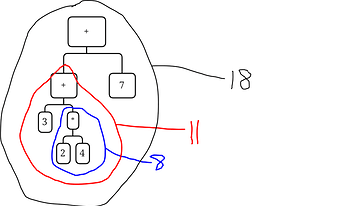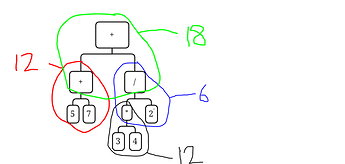You can make a tree for it with only the key words. That helps focus on looking at the structure.
I think the idea about main clauses is probably something I heard about at some point during K-12 education. I did some googling on main clauses and it looks like it’s somewhat common to use the terms ‘independent clause’ and ‘main clause’ somewhat synonymously. I can’t tell if they are both good terms or if it would be better to mostly use ‘independent clause’. It seems like ‘main clause’ is a good way to think about complex sentences (independent clause + dependent clause) but not necessarily a good way to think about compound sentences.
From what I can tell, compound sentences sometimes have a pretty significant precedence relationship between independent clauses but other times don’t have any precedence relationship. The masterclass link refers to ‘main clauses’ as a plural when discussing what they called compound-complex sentence structures. I did not expect that because I thought that main clause was a term indicating that this clause is the main idea of the sentence, so there would only be one. Here are the links to stuff I looked at:
https://www.monmouth.edu/resources-for-writers/documents/clauses.pdf/
Compound Sentences | Grammar | EnglishClub.
More recently, I thought I remembered hearing about ‘main clauses’ in Peikoff’s grammar course (only listened to the first lecture). I went back to check and about 3 minutes into the first Peikoff grammar lecture he mentions that the distinction between main clauses and subordinate clauses is a common source of error. He says something like, very often, when the emphasis of your sentence is off, it’s because the main thought is in a subordinate clause.
I re-listened to the subordinating conjunctions vs coordinating conjunctions part of the tutoring video #1 and made some notes:
-
Coordinating conjunctions (FANBOYS) can be thought of as joining approximately equal things
-
Subordinating conjunctions have a master-slave relationship.
-
‘But’ does have an order to it, as in the order matters, and there is an asymmetry.
-
Coordinating vs subordinating conjunctions are not a perfect distinction, they’re an approximation.
-
‘And’ is the most symmetric. The other conjunctions are varying degrees of asymmetric.
-
Reference to ‘main clause’ terminology, with regard to this sentence: ‘John ate after John sang.’ The main clause is ‘John ate’. The second part, ‘after John sang’, is acting bit like a modifier.
-
There is debate about whether conjunctions should be included in clauses.
-
The overall divide is whether conjunctions should be used as parents of two things or should you use conjunctions like modifiers. In the late case the conjunction is part on the clause.
-
I was using the right-side model of these trees:
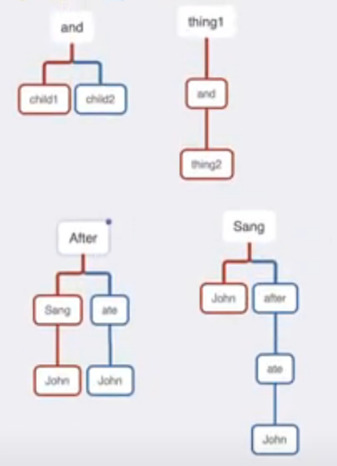
-
You (Max) point out that using ‘after’ as the root is more general than using ‘sang’. You say that using conjunction as the root of the tree then it’s clearer. You point out that it can be hard to figure out which verb to use as the root.
-
I agree that it was hard to figure out what verb should be the root but I also was thinking of the conjunctions phrases as more like modifiers.
-
ET says both models can work. Using the verb as the root has an extra layer. It’s best to be familiar with both models.
-
Most people use the left model with coordinating conjunctions and use the right model with subordinating conjunctions.
I have only glanced at your solutions and didn’t see most of them. I’m going to try redoing my trees according the conjunction-as-the-root model and see what I get. I will also see if I can address the other errors you pointed out as I go.
Good research.
Let’s call the left diagrams the conjunction or non-nested model. The right is the modifier or nested model.
It’s good to learn both but also to have a general policy for what to use (don’t try to make it up in each individual case – only switch from your default if there’s a major reason).
I strongly prefer the conjunction model for coordinating conjunctions. I prefer the conjunction model for subordinating conjunctions because clauses are significantly bigger and more important than typical modifiers like “the”, “red” or “very”. I prefer the modifier model for relative pronoun clauses like “I met Sam who is tall.” because the primary purpose of those clauses is to modify a noun. The relationship where “who is tall” is a modifier for “Sam” is clearer than calling “because clauses are significantly bigger and more important than typical modifiers like “the”, “red” or “very”” a modifier on “prefer”. The conjunction model actually works poorly for relative pronouns (it results in trees you probably won’t like), but it works OK for subordinating conjunctions (it does get messy when there are many clauses, but the main issue there is that sentences with many clauses are messy).
Yeah, Elliot explained this to me in one of the tutoring videos, but I think with more of an emphasis on putting ideas in prepositional phrases. Either way the effect was the same. I think we were analyzing Steven Pinker quote (and mb another one I can’t remember).
I think it was in Tutoring Max #13 from 28:13 and it goes for most of the rest of the session.
Sounds like a good exercise. It should be quick to rearrange the nodes and branches.
@Fire, I find this is generally easier/nicer for references (which mb are always pronouns in this case).
On thing that never sat well with me was using “that” as a conjunction. I spent many hours (~10+) researching “that” and consider different options – the one I settled on and liked the most was from Websters 1828:
4. that is also the representative of a sentence or part of a sentence, and often of a series of sentences. In this case, that is not strictly a pronoun, a word standing for a noun; but is, so to speak, a pro-sentence, the substitute for a sentence, to save the repetition of it.
So you’ll see in my grammar trees that I’ll often add “that” (or an implied “[that]”) as a node and have a clause underneath it. If you treat “that” as a conjunction in these cases, then it’s the nested model.
I found this rewriting useful to understand:
I think that water is wet. → Water is wet; I think that.
-
I work hard and I play hard.
Two equal independent clauses with a coordinating conjunction.
S-Expression: [and [work [I] [hard]] [play [I] [hard]]]

-
Farting or belching is mildly impolite.
One independent clause with a complex subject, ‘farting or belching’. I think ‘or’ makes sense as the root of the subject sub-tree because it is a coordinating conjunction that balances two equal parts of the subject. I’m not confident about that part of the tree but I couldn’t see how to make either ‘farting’ or ‘belching’ the root.
S-Expression: [is [or [Farting] [belching]] [impolite [mildly]]]
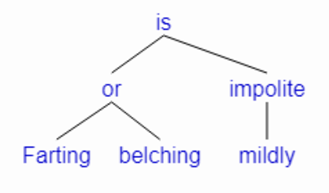
-
I went to a fancy university, yet I’m still quite ignorant.
S-Expression: [yet [went [I] [to [university [a] [fancy]]]] [(am) [I] [still] [ignorant [quite]]]]
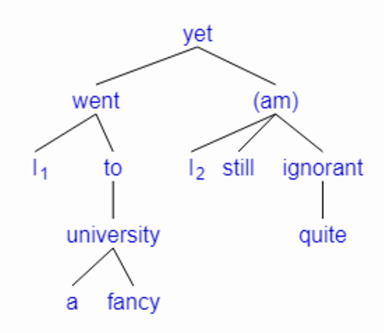
-
I write because I like good ideas.
S-Expression: [because [write [I]] [like [I] [ideas [good]]]]
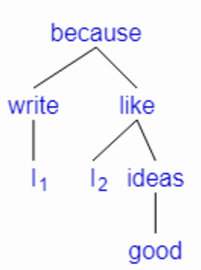
-
The bully hit my buddy and me pretty hard.
This sentence has one independent clause with a complex subject. I broke up the complex subject ‘buddy and me’ with ‘and’ as the root (similar to #11). After breaking it down it looks like ‘my’ is and adjective that modifies ‘buddy’.
S-Expression: [hit [bully [The]] [and [buddy [my]] [me]] [hard [pretty]]]

-
I seriously think that Ayn Rand was wise.
I read that ‘that’ can be removed in many instances without changing the meaning of the sentence and I think that applies here.
S-Expression: [that [think [I] [seriously]] [was [“Ayn Rand”] [wise]]]
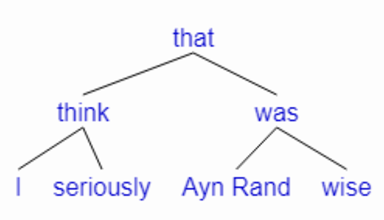
-
Don’t chew quickly while your mouth is open.
I see two independent clauses with a subordinating conjunction, ‘while’. I’m having a bit of trouble understanding the grammar of the first clause, ‘(you) (do) (not) chew quickly’. I think this is an imperative statement with an implied (you) as the subject. It looks like ‘(do)’ is an auxiliary verb here and I guess that puts ‘(do)’ in a sort of parent child relationship with the verb ‘chew’. As in, ‘chew’ is the main verb and ‘(do)’ is the helping verb. I read that ‘not’ is always an adverb and it seems that ‘not’ is a modifier of ‘do’.
S-Expression: [while [chew [(you)] [(do) [not]] [quickly]] [is [mouth [your]] [open]]]

-
My daughter likes big dogs, but my son likes adorable cats.
I see two symmetric independent clauses in this sentence.
S-Expression: [but [likes [daughter [My]] [dogs [big]]] [likes [son [my]] [cats [adorable]]]]
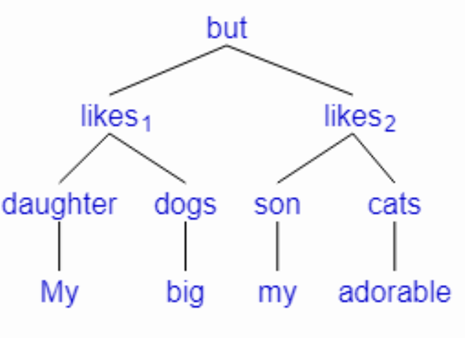
-
If universities are full of uncurious professors, don’t attend one.
Similar issues to #16 regarding the verb phrase ‘do not attend’.
S-Expression: [If [are [universities] [full [of [professors [uncurious]]]]] [attend [(you)] [(do) [not]] [one]]]
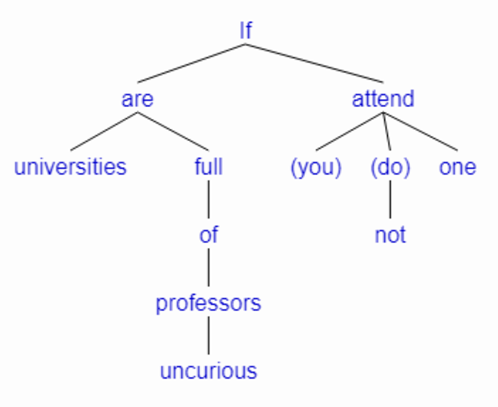
-
After you throw a small, red ball, while you sing, you should stamp your feet loudly, and you should clap your hands energetically, if it’s still daytime.
Figuring out the precedence of the ‘after’ conjunction and the ‘while’ junction was hard. I’m not all all this is correct overall, and that part especially. I was thinking at each conjunction has to take two clauses as inputs (as I recall from the tutoring video #1). It seems like ‘after’ has to have the ‘you throw…’ clause as a child and ‘while’ has to have ‘you sing’ as a child. So it comes down to which conjunction is the parent of the ‘you should stamp your feet loudly’ clause. Based on content and proximity/order, ‘you sing’ looks like it should be linked to ‘you should stamp your feet loudly’.
S-Expression: [and [After [while [sing [you]] [stamp [you] [should] [loudly] [feet [your]]]] [throw [you] [ball [a] [small] [red]]]] [if [clap [you] [should] [energetically] [hands [your]]] [(is) [it] [still] [daytime]]]]
-
When Jack came into the room, he began to remove his coat.
Both clauses could be independent without the conjunction ‘when’. If ‘when’ were replaced with ‘and’ then there would be a symmetric relationship between the clauses. However, using the conjunction ‘when’ makes ‘Jack came into the room’ a subordinate clause.
I also broke down ‘to remove’ in this tree.
S-Expression: [when [came [Jack] [into [room [the]]]] [began [he] [to [remove [coat [his]]]]]]
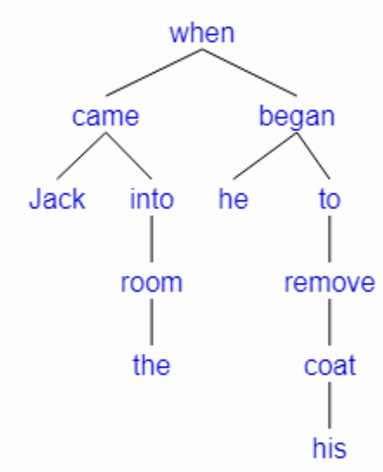
Re-do’s of sentences #4 and #8:
4. S-Expression: [went [John] [to [store [the] [new]]]]
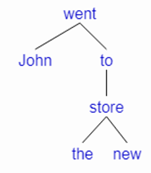
- S-Expression: [put [John] [soldier [the] [toy]] [in [compartment [the] [in [box [the] [on [shelf [the] [in [room [his]]]]]]]]]]

agreed for 11. “or” is making a group (tree or subtree, also a noun phrase in this case) and the group’s job is to be the subject for “is”.
I don’t agree with 15 or 19. “that” is tricky. nesting order with many clauses is tricky too.
generally looks pretty good.
“That” is often omitted but implied. I think that’s what the thing you read meant. I’m not sure it’s ever clearer to remove “that”, though.
What is the object of “think”? Should the object be a child of “think”?
Yeah, definitely a tricky one.
WRT “and” more generally, you should be able to swap the branches of “and” most of the time; the relationship between the clauses is often weak. If ordering is needed, then ppl will often use “then” or “and then” to sequence stuff.
So, does something like the following (which is based on your tree) match the meaning of the original sentence?
*if it’s still daytime then you should clap your hands, and after you throw a ball, while you sing, you should stamp your feet"
So, like based on your tree, you’re saying the daytime/clap branch is pretty separate from the after/while/stamp branch. The “if” conditional doesn’t apply to the whole thing, just the clapping. (That’s how I read it.) Does that line up with your reading of the original sentence?
FYI, I don’t do this, but I don’t think it’s much of an issue.
This explanation is really helpful. Just having some terminology for the two models felt like it was a bit more organized in my mind. Based on the video, I was thinking that the conjunction model was best for coordinating conjunctions and the modifier model might be better for subordinating conjunctions. It makes sense that subordinate conjunctions have more importance than simple modifiers. As I was redoing the trees, I found thinking about the hierarchy of the tree that way useful and more natural/intuitive than what I did the first time.
I had to re-watch the part of tutoring Max #1 about relative pronouns/clauses to get some more understanding of what they are. Here are my notes from that section:
• Max says “when we replace a noun with a pronoun, it can be a modifier, or it is a modifier”. ET replies “not exactly, most pronouns don’t do that”. I think, in the beginning of this section, is saying most pronouns don’t act as modifiers.
• In general, pronouns are references words that point at something else.
• Normally pronouns point at a specific thing, like ‘he’ points to ‘John’.
• Relative pronouns are somewhat like a cross between a conjunction and a pronoun.
• The relative pronoun does two things. It refers to a noun in the sentence and creates a whole clause, which is used as a modifier on that noun.
• Relative pronouns allow you to allow have another complete clause in the sentence.
From Purdue OWL:
The most common relative pronouns are who/whom , whoever/whomever, whose , that , and which . (Please note that in certain situations, " what ," " when ," and " where " can function as relative pronouns.)
- There are restrictive and non-restrictive relative pronoun clauses.
The Purdue OWL article had a lot of ideas in it and I only partially understand it. However, using the ideas above I think that I should have a decent ability to spot potential relative clauses.
Correction:
The quote,
The most common relative pronouns are who/whom , whoever/whomever, whose , that , and which . (Please note that in certain situations, " what ," " when ," and " where " can function as relative pronouns.)
is from this page:
Introduction to Defining Clauses - Purdue OWL® - Purdue University)
On some remaining differences:
#15. I seriously think that Ayn Rand was wise.
Some uses of the word ‘that’ are more optional than others. ‘That’ can introduce dependent clauses which function as objects of a verb. In the above sentence, ‘that’ appears to me to be functioning as a conjunction introducing the object of the verb ‘think’. Using ‘that’ here is optional in informal/casual speaking and writing, but does make the meaning of the sentence clearer.
When is ‘that’ a conjunction?
- One hint seems to be when ‘that’ follows the verb in a sentence, such as: ‘appears that’, ‘showed that’, ‘deduced that’, ‘asserted that’, or ‘reported that’.
- Another way to check is by reformulating the sentence into a question, and seeing if the ‘that’ clause answers any questions about the other parts of the sentence, especially the verb phrase.
When is ‘that’ a modifier?
- It looks like most potential modifier uses of ‘that’ are as an adjective. As an adjective ‘that’ is primarily a determiner.
- As an adverb ‘that’ is an intensifier or a comparator. ‘That’ can show some degree of surprise (e.g. ‘that bad’, ‘that hard’, or ‘that well’).
When is ‘that’ a pronoun?
- When ‘that’ is a pronoun, it can’t be removed from the sentence with the sentence still making sense.
- Sometimes ‘that’ refers to a noun in the immediate environment or something that has already been discussed. For example, ‘that was the living room’, refers to something in the surrounding environment. ‘That was the book I was just talking about’ is an example of a reference to a book you had previously brought up in conversation.
- As a pronoun, ‘that’ can be helping to answer questions like: Which one/instance/person/thing? Answer: ‘That one/instance/person/thing’. Also, what time/event? Answers: ‘before that/after that/at the same time as that’. Also, what kind/type? Answer: ‘that kind/type’.
Notes from Max Tutoring #4:
- Discussion of the sentence ‘I seriously think that Ayn Rand was wise’.
- ‘That’ is a very commonly omitted word.
- Rearranging the sentence into ‘Ayn Rand was wise; I seriously think that’, makes ‘that’ clearly a pronoun which refers to what you thought (about Ayn Rand).
- ‘That’ serves two roles in the sentence ‘I seriously think that Ayn Rand was wise’. It is a conjunction and a pronoun.
- One way that the function of ‘that’ is taught, for a sentence like this one, is that ‘that’ is simply a subordinator creating a subordinate clause. That subordinate clause is the object of think.
- What is somewhat odd about the way ‘that’ is taught in these instances is that a clause playing the role typically played by a phrase. I don’t know enough to why clauses playing the role of phrases is strange in this regard.
- ET says that he would have ‘that’ as the object of ‘think’. That makes sense when thinking of ‘that’ as a pronoun.
- ‘That’ can show up twice in the tree diagram since it has two roles. I will be looking out for ‘that’ having multiple roles in sentences. Are these two roles always pronoun and conjunction?
- You can think of this sentence as having an implied semi-colon or an implied ‘and’.
I googled ‘can a clause be an object’, and many of the examples of clauses as subject complements or direct objects are sentences with the word ‘that’. I did find a Quora answer that seemed to make sense as to how noun clauses can be objects. That answer had examples using ‘when’, ‘where’, and ‘how’ to introduce the noun clause object. I found another example at parentingpatch.com: “The boss did not mention whether you were attending the party.” In this one, ‘whether’ is the conjunction for the object ‘you were attending the party’. I think you could also replace ‘whether’ with ‘that’ to get a similar grammar structure, but with a different meaning.
I’m still pretty confused/overwhelmed with the variety of uses of ‘that’. I think I will need to do more practice and research as problems arise with other sentence diagrams.
Resources for the word ‘that’:
#16. Don’t chew quickly while your mouth is open.
What is the main verb and what is the helping verb? I have ‘chew’ as the main verb and ‘do’ as the helper/auxiliary verb. I watched part of the tutoring video #2 and saw discussion related to this issue in the section: Verbs in “John had been playing golf.” In this sentence ‘playing’ and ‘been’ are in mixed states with regard to their functioning as verbs. ‘Had’ is the only verb that is functioning solely as a verb. In applying that idea to ‘don’t chew’, I’m thinking that ‘do’ is the word functioning solely as a verb, ‘not’ is an adverb, and ‘chew’ has a more mixed function. So, ‘do’ should be the parent of ‘chew’ in the tree.
#18. If universities are full of uncurious professors, don’t attend one.
My tree says there is an imperative statement in the second clause but after consideration I think the conditional, with an implied ‘then’, does make more sense. Perhaps the imperative (you) is still implied within the clause underneath ‘then’.
Is there really an implied (you)? If so, is it important to include the implied (you)?
In this sentence I guess there is not an implied (you) because the meaning of the sentence can be read as more of an abstract statement about the decision to enroll in university. Whether there is an implied (you) depends on context, like whether this statement is in response to someone questioning their decision to go to college in light of some negative information about professors. In that context, I guess there could be an implied (you) but even then, (you) would not necessarily be implied.
#19. After you throw a small, red ball, while you sing, you should stamp your feet loudly, and you should clap your hands energetically, if it’s still daytime.
Many differences/problems/confusions. I have been reading this sentence as two main ideas, with ‘and’ conjoining them. Points one and two in the list below are both part of what I have been seeing as the first idea. The second main idea is a smaller conditional statement; if daytime => clap hands.
- After you throw a small, red ball, you should stamp your feet loudly.
- The above mentioned ‘feet stamping’ should be happening ‘while you sing’.
- ‘And’ in addition to all the above, ‘if it’s still daytime, you should clap your hands energetically’.
I can see some problems with the above interpretation, like ‘if it’s still daytime’ makes more sense with the ‘after you throw…ball’ clause. Without the ‘after…’ clause, the only reference that the statement ‘if it’s still daytime’ would have to time is the implied reference to the time at the moment the sentence is said. The ‘after…’ clause makes the sentence more self-contained by providing context for the ‘if…’ clause.
I’m going to try to simplify and reword the sentence to see if I can break it down more effectively. When I read the sentence with an ‘if’ as the root it looks like the following to me:
- If it’s still daytime after you have thrown the ball, then you should stamp your feet and clap your hands.
- However, I cannot see where the ‘while singing’ comes in.
- The confusion that is coming up for me is what I see as possible alternative meanings in this sentence.
- Is the singing happening at the same time as the feet stamping and clapping?
- Or is the singing happening at the same time as you throw the ball?
- Including ‘singing’ and starting with ‘if’ the reworded/simplified sentence looks like this to me:
- If it’s still daytime after you have thrown the ball, then you should stamp your feet, clap your hands, and sing.
- In that wording, singing, clapping, and stamping are all happening at the same time.
In Max’s tree I see the sequence of events as you throw the ball while singing and then evaluate if it’s still daytime. If it is daytime then go on with the stamping and clapping. I don’t see any reason why this cannot be the meaning of the sentence but I guess it’s just hard for me to tell either way.
More notes from Max Tutoring #4:
- Discussion of ‘After you throw a small, red ball, while you sing, you should stamp your feet loudly, and you should clap your hands energetically, if it’s still daytime.’
- ‘after’ introduces a subordinate clause
- ‘while’ introduces a subordinate clause
- ‘You should stamp your feet loudly’ looks like main clause.
- ‘And you should clap your hands energetically’ appears to be a coordinate clause.
- ‘if’ introduces subordinate clause
- When linking nodes with a subordinating conjunction the main clause goes as the first child and the subordinate clause as the second child. So, the subordinating conjunction is the root node.
- Order doesn’t matter too much because all three subordinate clauses are modifiers on the [main clause + coordinate clause].
- There is a subordinator version of the tree for this sentence with ‘and’ as the root node having five branches to all the other clauses. The ‘after’, ‘if’, and ‘while’ conjunctions take their own clauses as children and output modifiers on the two main clauses.
- I like the subordinator model because it bypasses some of the nesting issues that came up.
Overall, I’m thinking that more practice with a variety of multiple clause sentences will be quite useful in getter a better idea about these issues.
I’m still pretty confused/overwhelmed with the variety of uses of ‘that’. I think I will need to do more practice and research as problems arise with other sentence diagrams.
Depends on your goals. You should consider how this project fits into some bigger picture goals and then what outcomes for the project are relevant or needed for those bigger picture goals.
What is the main verb and what is the helping verb?
They are more technically called finite and non-finite verbs if you want to look it up. But whether you should do that, or consider your understanding good enough, depends on your goals.
Many differences/problems/confusions. I have been reading this sentence as two main ideas, with ‘and’ conjoining them.
If you want to understand nesting/grouping/trees better (which has a lot of importance beyond grammar), it might help to try it in other contexts besides grammar, e.g. arithmetic trees https://www.youtube.com/playlist?list=PLKx6lO5RmaeudDlX36T8Y__fq2RDVhFN- (math trees start in the 2nd vid). Another context is outlining a story, essay or concept. Dealing with nesting in other contexts can clarify what is grammar-specific and what is more general, and can help you learn about nesting without problems related to grammar distracting you.
I just want to mention that I’m continuing to appreciate your responses and finding these prompts useful for getting me to think.
Broader context/goals:
During the rest of 2022, my medium-term goal with grammar is to automatize grammar knowledge that will cover 97%-99% of sentences. I would like to have explicit knowledge and tools for analyzing most of the last ~1%-2%. I don’t know if the percentages here are realistic but I’m just trying to convey something of the way I’m thinking about all of this.
I still feel like I’m firmly in the “I don’t know what I don’t know” category with my grammar understanding. It seems super important to at least get over that hurdle. I have been relying almost entirely on implicit knowledge and context clues for most reading.
My idea is to finish doing grammar analyses on the rest of the sentences in your grammar article, then go on to Peikoff’s grammar course. I plan to do a bunch more grammar trees during and after that course. I also want to try sentence diagramming and look for some other ways to conceptualize understanding the subject. To that end, I plan to do a series of mini-research projects on various small topics/issues in grammar (e.g. finite vs non-finite verbs). I don’t want my knowledge of grammar to be fragile and break in the face of variations. I want to have built a good knowledge structure or a good psycho-epistemology for grammar. I only have some vague ideas about knowledge structure and how to organize ideas but that is one of the things I intend to get into as I learn grammar.
In a few months, I plan to start a similar series of projects for learning logic, idea trees, and basic discussion patterns. I don’t know if those are the next best projects to pursue and I’m totally open to better suggestions. I’m expecting these projects to be overlapping with my grammar projects. In the long-term, like next 5-10 years, I would like to really learn philosophy. I recognize that there is an overwhelming chance of failure but I think it would still be fun to try and at least make some progress.
Arithmetic Trees Practice (from Tutoring InternetRules #2):
As I was watching, I thought that the trees would end up having the result at as the root node. For example:

Now using the method as shown in the video:
Ex.1)
5 + 2 = 7
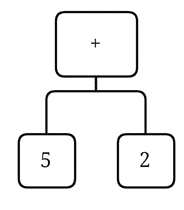
Ex.2)
3 + (5 + 2) = 10
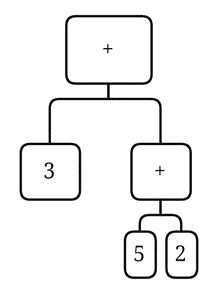
Ex.3)
4 + 3 * 2 = 10
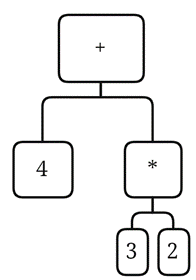
Ex.4)
(6 + 2) / 4 * 2 + 1 = 5
I had to think about this tree for a bit and I’m not sure it’s right.

Interesting notes on things I had never heard of before:
-
Infix vs prefix vs postfix notation for arithmetic expressions.
-
Infix: 3 + 4
-
Prefix: + 3 4
-
Postfix: 3 4 +
-
Prefix works well for displaying addition of many numbers using only one + sign (e.g. + 3 6 2 1 = 12)
-
When using the trees, you don’t have to know order of operations because the order is given by the structure of the tree. You tell a tree is valid when every leaf node is a number and a every other node is an operator. Allowing for operators as leaf nodes that represent a zero helps with exception handling type error correction.
-
Multiplication is repeated addition.
-
Division is repeated subtraction (e.g. 9/3 = how many times can you subtract 3 from 9?). Order matters for subtraction and therefore for division as well.
-
Exponents are repeated multiplication (I have heard this one explained similarly to the way it was done in the video).
Project Conclusion:
I have posted the 20 sentences analyses that I planned to do. The posts from Max and Elliot were really helpful and much appreciated. While knowing that I had basically no explicit grammar knowledge, I had more errors than I expected. I had even more opportunity for improvement than I expected.
I learned a lot about how to make grammar trees since I was starting from near zero. The tutoring videos were really helpful in this regard. The videos were also good for learning about the grammar of the example sentences in general way, as in how to think about sentence structure.
I think this project was an overreach because of the way it was planned. The planning done at the time of filling out the project template was not realistic. I underestimated the amount of time it would take to complete the sentences by about 50% and didn’t factor in any time for learning from errors. In fact, I spent about as much time on trying to learn from my mistakes as the original goal. I left the amount of time to complete the project a bit vague and hedged about how long I expected it to take. I think I will do better to set out a specific amount of time for getting the basic project done and a separate specific amount of time allotted for error correction (even if it is just looking for my errors by myself). The lack of specific pass/fail criteria made the project overall a failure; albeit a very fruitful failure. I think it was a good project but needed better planning and I should have started with something smaller or more organized.
It’s contextual what number would make sense as a default or fallback. When adding or subtracting, a 0 is the most neutral number, but multiplying or dividing by zero isn’t neutral at all. For those operators, a 1 is most neutral.
I had to think about this tree for a bit and I’m not sure it’s right.
You can check by going through the tree step by step to calculate the total, and also going through the math expression step by step, and comparing the steps.
I thought that the trees would end up having the result at as the root node
If you want to include the total in the tree somewhere, you can use = as the root node.
In the long-term, like next 5-10 years, I would like to really learn philosophy
Why?
And if you don’t mind my asking, what’s your school and career situation? And, related, what are your expectations for free/available time in the coming years?
It’s contextual what number would make sense as a default or fallback. When adding or subtracting, a 0 is the most neutral number, but multiplying or dividing by zero isn’t neutral at all. For those operators, a 1 is most neutral.
I didn’t think of that. So, it seems like the neutrality of those leaf nodes is related to the identity property. The identity for addition/subtraction is zero and for multiplication/division the identity is one. You would have to be careful with division and subtraction too because the order matters for the identity to hold. I’m thinking that the arithmetic trees are always meant to be read left to right as well.
You can check by going through the tree step by step to calculate the total, and also going through the math expression step by step, and comparing the steps.
A couple practice trees breaking down the calculation:
This step-by-step calculation has more of a subsuming/hierarchal form. It was still a bit hard to follow. I felt like I needed to do double checking to ensure accuracy.
I broke this one down with a bit more overlapping. The colored circles are meant to include just the minimum nodes necessary to the operation at that step. It seemed to feel a bit more intuitive.
If you want to include the total in the tree somewhere, you can use = as the root node.
Trying = as the root node:
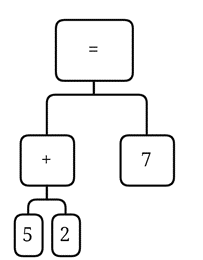
Why?
At a conscious level, I’m convinced that using reason and learning are the path to having a really great life. I’m vulnerable to bad ideas and have a tendency to think rationalistically about philosophy, like an armchair philosopher. At the same time, I live mostly by intuition because I get paralysis by analysis. All this is to say, my thinking methods are not good and I partially recognize that is contributing to not having a great life.
I had something of the idea that knowledge could fix problems, and that that would lead to better outcomes in life, before hearing about fallibilism. I also had something of an idea about powering up in skills and accomplishing a lot once I’m really knowledgeable. I didn’t really have any plan for what to learn but I already thought that more general knowledge is better. After finding out about CF, I have become increasingly convinced that learning how to learn using philosophy is going to be the best way to power up.
Another important thing is that I enjoy learning and I like thinking/reading about philosophy. There are a variety of skills that I find it fun to get better at.
And if you don’t mind my asking, what’s your school and career situation? And, related, what are your expectations for free/available time in the coming years?
My career situation is not too good but I have a decent amount of free time. Sometimes it’s a bit intermittent but I’m never truly really busy with super important stuff. I have a college degree but I’m sort of going back to school with a couple online community college classes but they don’t take a ton of effort. I think that I will try to switch careers into something more software related in the next few years, or hopefully sooner.
As for free time that I can devote to philosophy, I think my main constraint is mental energy due to passivity and enjoying passive entertainment. With the caveat that I don’t track my schedule and plans well, I think it’s plausible that I can average 5 hours per week on philosophy. The distribution of that would probably be more like 10+ hours in 20% of weeks, 5+ hours in 50% of weeks, 2+ hours in 80% of weeks, and 1+ hours in 90% of weeks.
I think it would be good if I averaged over 10 hours per week regularly but that may not be realistic for who I am right now. Hopefully my time devoted to learning philosophy can get there as I get better at stuff like scheduling, being proactive, and introspecting.

